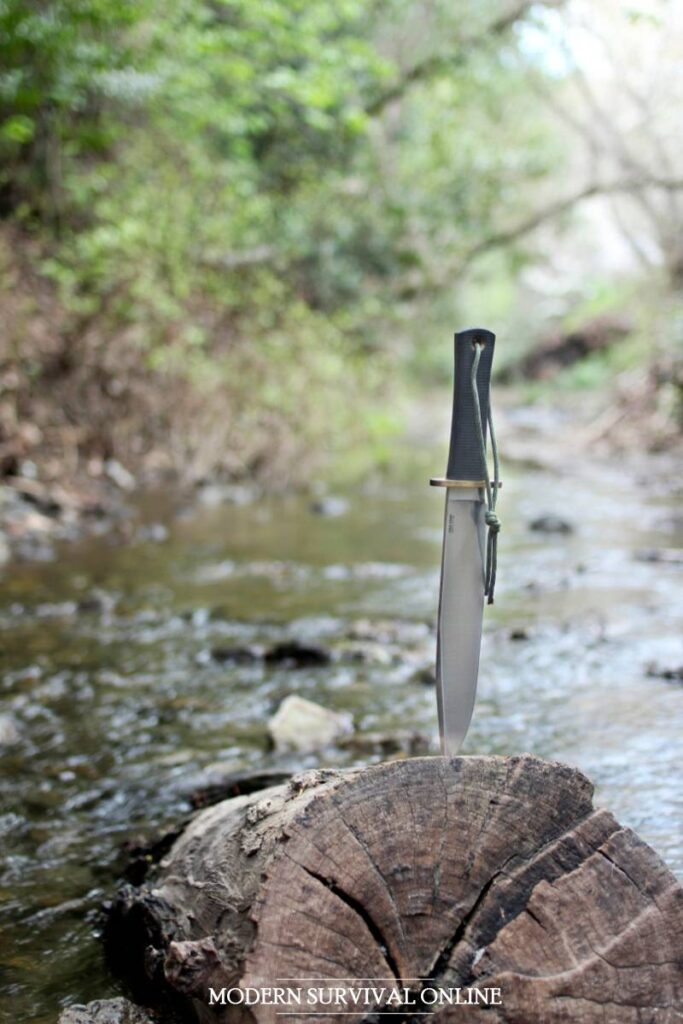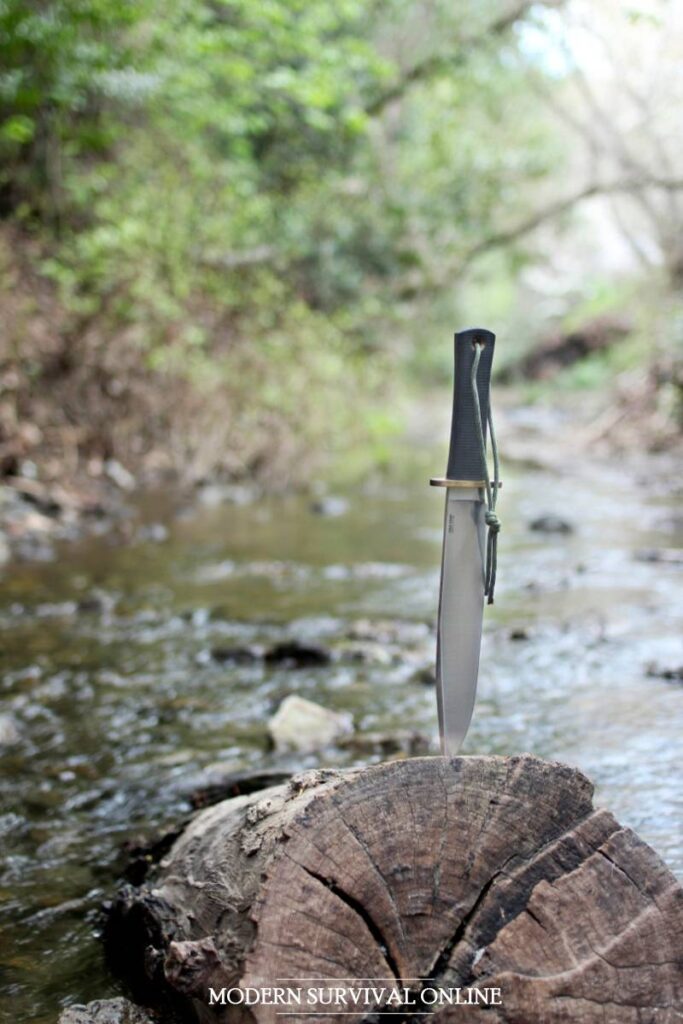Picking the right knife for your purposes is almost a rite of passage in prepping. A simple knife is going to be one of the most commonly used and most important tools you’ll have to rely on in a survival situation, and it will be called on to help you complete all kinds of tasks. Two kinds of knives that are often mentioned in the conversation are bushcraft and survival knives.
So what are the differences between bushcraft and survival knives?
There really isn’t much of a difference when comparing bushcraft and survival knives. They’re both capable of tackling all kinds of tasks around camp, in the field, or on the trail. Both can easily handle typical functions when you need to create a shelter or process wood for building a fire.

If you really wanted to split hairs you might say that a survival knife includes a survival kit or survival supplies with it, typically stashed on the sheath or within the handle of the knife, but this is far from a rule.
Instead of getting down to the nitty-gritty and trying to pigeonhole a knife into one category or another based on nearly meaningless differences, your time would be better spent learning what characteristics make for a quality bushcraft or survival knife.
Either one will definitely do the trick when you are in a survival situation! In the rest of this article will provide you with some guidance for choosing a good one.
Essential Features of Bushcraft and Survival Knives
Before we begin, you must keep in mind that any given survival tool might be optimized for a certain survival situation.
Survival in the desert looks very different from survival in a forest, though the survival necessities- air, shelter, water, food- remain the same. Understanding this, a knife that is optimized for one environment might not be ideal for another.
Most bushcraft and survival knives are created with the idea that the person carrying and using it will be in an area where trees or other tough plants that require processing can be found. This assumption informs their design.
As a rule, survival and bushcraft knives are both solidly built, usually featuring thick and chunky blades with flat, squared-off spines.
Emphasis is placed on edge retention more than geometry that will support a screaming sharp edge. The reason these knives are so stout is so they can stand up to the typical tasks asked of them in a survival situation.
One hour they might have to notch out wood to help you with shelter creation. The next hour they will be repeatedly pounded with a branch to baton through small logs in order to create firewood.
This, as you probably already know, is very harsh treatment for any tool, and especially a knife. Not all knives will hold up or will hold up for any time to such treatment.
Treating a common folding pocket knife this way is liable to destroy it in short order, or at the very least create dangerous amounts of play in the action. Any survival or bushcraft knife worth the name will easily withstand such heavy duty use.
The point design of a survival or bushcraft knife is an area of considerable variability, since most of these tools are edge driven, not point driven.
The classic clip point is popular as are drop points, spear points and hybrids thereof. The point is still not an afterthought on such a tool because it will be used for shallow drilling, scoring, engraving and more.
Some survival or bushcraft knives might emphasize a point design capable of precise detail work, or even skinning game where others will want the strongest point possible for added durability.
The handles of such knives show some variation but typically fall into one of two categories.
Ergonomic handles with prominent finger coils are popular, as they afford maximum control no matter the task and also provide assurance that the user’s hand will not slip on to the edge in times of maximum exertion.
Other popular options are more traditional round or oval handles that are least likely to create blisters or hotspots during the most heavy-duty chores.
One design choice that rarely varies no matter what kind of knife you are buying is the handle texture. Survival or bushcraft knives typically provide handles with a modicum of grip since perspiration, water or even blood could impede one’s grip.
However, as a rule they will rarely feature the most aggressive textures or treatments compared to tactical or fighting knives because these will once again promote blisters far too regularly.
Options
Again, there is no “standard” survival or bushcraft knife. Various schools of thought and design exist for this category of knife and the need to “create a better mousetrap”, thus selling more knives, is a constant for manufacturers and designers.
Serrations on the blade are a love it or leave it feature for most knife owners. It remains so when considering these knives. Situations are definitely helpful for cutting through tough, fibrous materials both natural and man-made.
They can make sure rope, paracord and nylon webbing alike while keeping your primary edge in good shape for other jobs.
Periodically you will also see a bbushcraft or survival knife with a wickedly serrated spine or even proper saw teeth.
This is intended to give the user the option of cleanly cutting through wood or other materials. This idea has some merit, but should you need to genuinely saw through something you are much better off using an actual saw for the purpose.
These features significantly increase the chances of snagging the knife and can make pulling it free from something very difficult. Think hard before committing to full-length spine serrations or a sawback spine.
What about the Survival Kit?
A knife specific survival kit is a contentious topic among preppers. On one hand, having survival supplies as part of a dedicated package with your knife means if you have the knife you will have a few additional tools and supplies that are genuinely valuable in a survival situation.
On the other hand, some preppers believe they are extraneous, wasteful and just take up room and space considering you are likely only carrying a dedicated survival or bushcraft knife when you are heading into a potentially dangerous situation.
Both ideas have merit, but if I were to provide you with any caution on the subject I would warn you against choosing any cheap survival knife that features a flimsy handle that unscrews, or otherwise opens to a small compartment where survival supplies are stored.
These knives, as popularized by the Rambo series of movies, are rarely made to anything approaching an adequate standard of quality and many of them are novelty items at best.
If you have to have a knife with an onboard stash of survival supplies you are far better off to get one where the survival items are stored in the handle securely beneath the scales which are bolted or screwed on.
Far and away the best way to incorporate a survival kit with a survival knife is simply by storing the additional supplies on an oversized sheath that has pockets and pouches for the purpose.
Conclusion
Call it a bushcraft knife or call it a survival knife, knives that fit into this category are more or less identical, unless you want to really split hairs and declare that survival knives always include a survival kit or other supplies.
Despite the presence or lack of any accessories the build and function of knives in this category is broadly identical.


